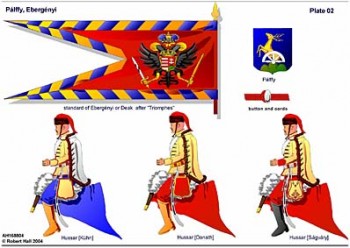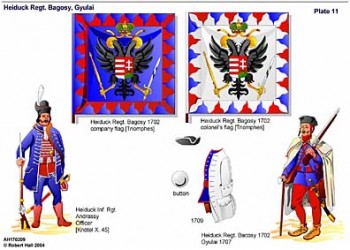Hussar units turned up again and again as light horsemen in the Imperial army since the coronation of Ferdinand I to King of Hungary on the death of King Louis II Jagello in the Battle of Mohacs 1526. According to the military constitution introduced by King Mathias Corvinus in 1480 every Jobabyok or free farm had to provide one well mounted lightly armoured horseman which were then already known as husarones, the word “husz” meaning “20” and “ár” the “price” in Hungarian. Other sources, including those from Hungary, relate the word hussar to the Serbian Gusar this in turn from the late Latin name cursarius, meaning a plunderer or robber, still extant in the English word “corsair”. At the time of Corvinus the pointed helmet or kutsma-kalpak of skin with a cloth sack or of felt, decorated with wild birds
feathers, was worn together with a armoured coat, shield, often a bow but also long saddle pistols and a lance, copia, decorated with a small flag. Tight breeches and csismen (short boots) completed the equipment which remained the usual appearance of small elite units in the regiments up until 1704.
In the course of time the number of light cavalry in the Imperial army increased. Among the 52000 man strong army of 1661 there were only 500 paid light cavalry. For the war of 1664 against the Turks 7 regiments were raised but disbanded again at the end of the war. By 1683 there were 5980 mercenary cavalry on the borders. The events of that year prompted raising standing regiments. On 30th Jan. 1683 Franz Barkóczy received a commission and on 19th June 1685 Stephan Gombos and David Peteházy were commissioned to raise a regiment each. The regiment of Barkóczy lasted until 1688 and those of Gombos and Peteházy until 1692.
However, these regiments were still classified as free corps since they fought largely for booty rather than pay. Similar units continued to be raised during the last years of the 17th century, such as that of Nikolaus Bercsényi, later a general of the Kurutzen1 rebels, who was commissioned to raise regiments of foot and cavalry and to “march up into the Empire because Prince Loi (Prince Louis of Baden) has written to His Majesty that if he should send him two or three Hungarian regiments he would surely beat the French”. In fact it was the experience of Prince Louis with the hussars in Hungary that prompted him to promote their incorporation into the army proper. This resulted in the foundation of the first permanent formations in the Imperial army. With the beginning of the Nine Years War in 1688 Adam Czobor received a commission to raise two hussar regiments. He commanded the first himself and had his son-in-law, Johann Pállfy, nominated colonel of the second. On Czobor’s death in 1691 the command of his regiment passed on to the officer commanding, Adam Kollonits. On 28th November 1695 Paul Deák (Nesztorovics) or, as he is better known after his service in the French army, Paldeak or Poldéak, received a commission to form a regiment. On the initiative of Prince Eugene of Savoy, who had also positive experience of the usefulness of the light cavalry in the Turkish wars, a further 5 standing regiments were raised at the beginning of the War of the Spanish Succession in 1702.
Contents:
Contents.......................................................................................................................... 2
The Imperial Hussars and the Hungarian Infantry during the War of the Spanish Succession ... 3
Costume in general........................................................................................................... 6
Imperial Hussar Regiments in the early period..................................................................... 8
Hussar Regiment Pálffy, Ebergényi 1688/4.......................................................................... 8
Hussar Regiment Czobor, Kollonits 1688/5 ....................................................................... 10
Hussar Regiment Deak, Viszlay, Splényi 1696/1 ............................................................... 11
Hussar Regiment Forgách, Lehoczky, Babocsay 1702/2...................................................... 13
Hussar Regiment Esterházy (Alt-Esterházy) 1702/3 .......................................................... 15
Hussar Regiment Csonkabég (Czungenberg) 1702/4 ........................................................ 16
Hussar Regiment Gombos 1702/5.................................................................................... 17
Hussar Regiment Loósy, Esterházy 1702/6 ...................................................................... 18
Hussar Regiment Ocskay (Militia) 1708/1........................................................................ 18
Hussar Regiment Nádasdy (Militia) 1708/2....................................................................... 19
Hussar Regiment Esterházy, Joseph (Militia) 1708/3.......................................................... 19
Hussar Regiment Jenay (Militia) 1710/7 .......................................................................... 19
Kaiserliche Insurektions – (Militia) Hussars:..................................................................... 21
Heiduck regiments........................................................................................................ 22
Imperial Heiduck regiments:.......................................................................................... 22
Heiduck Regiment Andrassy........................................................................................... 22
Heiduck Regiment Batthyány ......................................................................................... 23
Heiduck Regiment Bacosy, Gyulai .................................................................................. 23
Heiduck Regiment Molnar ............................................................................................... 23
Heiduck Regiment Neumann ........................................................................................... 24
List of plates .................................................................................................................. 27
Sources ........................................................................................................................ 28
The Imperial Hussars and Hungarian Infantry during the War of the Spanish Succession (Part 9)
Materials on the War of the Spanish Succession
August Kühn (revised by Robert Hall)
Год издания: 2004
Язык: английский (eng)
Формат: PDF (OCR)
Страниц: 41 pages
Размер: 3.6 mb










